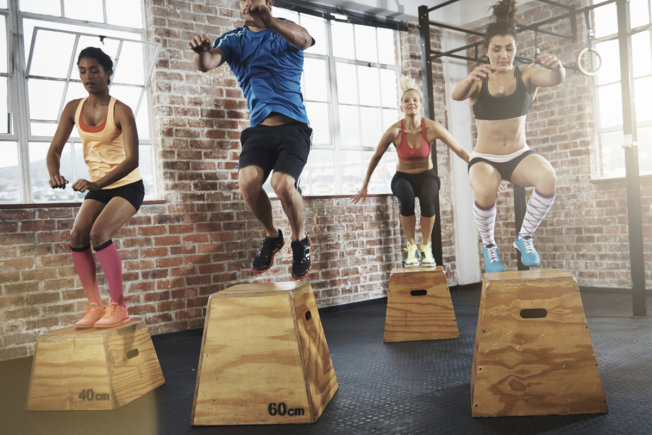
“Don’t run. It’s hard on your joints.” “You should try swimming. It’s low impact.” “Stay away from high-impact exercise.”
In recent years, “high impact” has become something of a four-letter word. “When people hear something is high impact, they immediately think ‘jarring’ or ‘tough on joints.’ And traditionally people associate high-impact exercise with injury and joint damage,” says California-based certified strength and conditioning specialist Mike Donavanik.
But there are plenty of reasons to hit it hard with high-impact exercises such as running, jumping and plyometrics – especially when it comes to preventing injury and strengthening your joints. A 2015 study in the American Journal of Health Promotion found that women ages 25 to 50 who hopped at least 10 times twice a day, with 30 seconds between each hop, significantly increased their hipbone density after four months. Those who hopped 20 times a day showed even greater bone-strength gains. Meanwhile, those who kept both feet flat on the floor actually lost hipbone density in just four months.
“As with other tissues of the body, bone is living tissue that responds to stress placed on it. When load is placed through the bone, it adapts by creating more bone, making it stronger and denser. High-impact exercise such as dancing, aerobics, jogging and hiking can provide this stimulation,” explains Dr. David Wang, a primary care sports medicine physician at the Hospital for Special Surgery Paramus Outpatient Center in New Jersey. Low-impact exercise like swimming and cycling, however, doesn’t stress the bone to the same degree, so it doesn’t result in the same amount of bone growth. That’s why gymnasts boast some of the population’s greater bone density levels – greater, in fact, than those of swimmers, says Dr. Susan Joy, a sports and exercise medicine physician with Cleveland Clinic Sports Health and a consultant for the Cleveland Cavaliers.
Plus, contrary to what most exercisers fear, plyometric jumping exercises prevent knee injury, per research in the Journal of Athletic Training. By training the legs’ stabilizing adductor and abductor muscles, they help knee joints stay aligned and strong. One study of nearly 100,000 runners and walkers found that running doesn’t increase the risk of osteoarthritis, or cartilage breakdown, in runners, even marathoners. Knee osteoarthritis was half as prevalent in runners as it was in walkers, according to the research published in Medicine & Science in Sports & Exercise.
“High-impact exercise strengthens the joints because it trains all the muscles around that joint to become functionally stronger. For example, when you hop up, you powerfully fire up a plethora of muscles to launch you off the ground. And when you land, those muscles need to contract eccentrically to brace for and soften that impact. While you can do low-impact strength training, you won’t be able to replicate that exact powerful explosion or same eccentric contractions that come from higher impact exercise,” Donavanik says.
And, of course, high-impact exercises max out your exercises’ loading force to up muscle strength and burn calories like crazy, Joy says. “People see dramatic improvement in ability to burn calories and build muscles with high-impact exercise. It’s profound.”
Think of it this way: Perform 20 squats, and you’ll be working hard. Perform 20 jump squats, and you’ll be winded, your legs will burn and regular squats will seem easy. That all-out burst of energy forces everything in your body to work harder. The harder you work, the more calories you’re going to burn, Donavanik says.
Before you Jump to It
“It’s very easy to go out and get into running or other high-impact sports way too fast, way too hard, way too soon,” explains certified strength and conditioning specialist Kourtney A. Thomas, owner of Lagniappe Fitness in St. Louis. “Then all of a sudden, aches, pains and sometimes serious injuries start to pop up. Of course, high-impact exercise does have potential for positive changes in the body, but it also carries the potential to cause injury.”
Without a good base of strength and joint control, jumping into high-impact exercise can excessively stress the joints, Joy says. For example, many people have poor form when completing squats, their knees caving in toward each other. While that form won’t immediately lead to injury if you are performing body weight squats, they definitely could if you are performing jump squats, she says.
“If you’re new to high-impact exercise, make a plan to ramp up. With running specifically, that likely means starting with a run/walk program, gradually increasing time spent running over several months. Take the time to build a base,” Thomas says. “If you’re wanting to incorporate plyometrics into your training, seek out a qualified strength and conditioning specialist to show you the proper form for each exercise and introduce you to the proper amount of these exercises to add to your training.”
What’s more, it’s important, especially for those with existing joint problems, osteoporosis or arthritis to listen to their bodies and give themselves ample recovery time between high-impact workouts, Joy says. “Even too much of a good thing is still too much.”
Written for Health.USnews.com